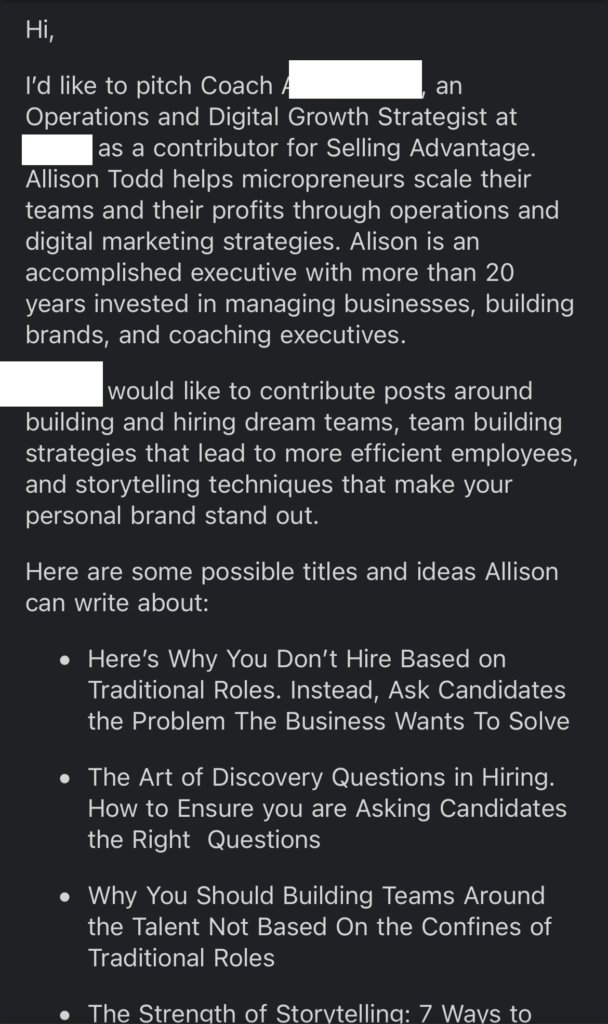In today’s issue, I’m going to share 3 cold message sins I see when training SDRs, and how to stop doing them.
These sins are almost always the results of new reps using poorly crafted templates.
And in most cases, SDR leaders and sales enablement never had to prospect, or did it too long ago to stay relevant.
Here are the top 3 sins I see when I meet SDRs:
Writing a cold email or a cold LinkedIn message is about two things; stopping prospects in their tracks, and getting them to read what you wrote.
Unfortunately, most SDRs I meet confuse cold outbound with essay writing. They write long emails, filled with value propositions, features, and filler words.
When prospects receive an email or a LinkedIn message, they quickly scan them to decide if they should keep on reading or ignore. And when your message is too long, they simply ignore it.
What to do instead?
I alway recommend writing short messages, maximum 125 words. Your prospect should be able to read the message on their smartphone, without scrolling. Use short sentences and jump lines between each sentence.
Look at the two emails below. Which one are you more likely to reply to?


When you start a new job as an SDR or as an AE, you’re trained on your offering, its features, benefits, USPs, why it’s better than your competition, and so on.
You’re almost never trained on the problems your offering is solving for your customers, however. And this is the explanation behind all the crappy cold outreach prospects receive.
When you focus on your product or solution, you bore prospects out and they end up ignoring you.
Your prospects have been hired to do a job, and there’s almost always a gap between their goals and reality. Reducing this gap is what they care about. They couldn’t care less about what you are selling, but they’ll care about solving their problems.
What to do instead?
Leading with the problems your prospects may be facing is how you improve your reply rate.
Think about how infomercials are focusing on problems before proposing a solution. There’s always a black and white part where the narrator focuses on how the current product leads to terrible results.
Your goal is to create the same effect by leading with typical problems your prospects may be facing. Google “{Prospect} problems 2022” to find typical issues your prospects are trying to solve.
(Note: You can also check The Cold Message System if you want to discover the messages that get me a 38% reply rate and a 27% meeting rate.)
Finally, a cardinal sin I see too often is the premature use of meeting links in cold outreach.
Your job is to start conversations, not to book meetings at all cost. A meeting link (think Calendly, Chili Piper), is a productivity tool. Something you use to facilitate the process of booking a meeting when both parties agreed to it.
When you use a meeting link as a call-to-action, you’re asking too much from your prospects too early. It kills your chances of starting a conversation.
What to do instead?
Ditch the meeting link in your cold outreach messages. You can use the following framework to:
Explain why you’re reaching out
Show prospects you understand their problems
Tease a potential resource
Ask to reply to access the resource
When you get a reply, navigate the conversation with a reciprocity resource and only share your meeting link when the prospect agreed to a meeting.
Getting replies from cold outbound messaging is harder than ever. You need to optimize the content of your messages, as well as the format. It’s all about your prospects and their problems, and never about your offering.
So keep in mind:
Write short messages
Focus on prospects problems
Ditch the meeting link
I hope this helps!
Get my free, 4 min weekly newsletter. Used by 5.900+ salespeople to book more meetings and work when, where, and how they want.
Get my free, 4 min weekly newsletter. Used by 5.900+ salespeople to book more meetings and work when, where, and how they want.
I will never spam you, or sell your info.
Get each episode in your mailbox when they release. Grab special discounts and offers.